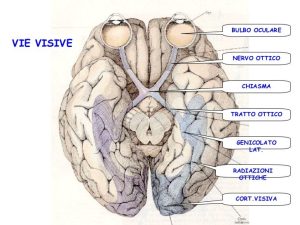L'hemianopsia is a visual disorder that causes the loss of half of the visual field.
Classification
There is talk of lateral hemianopsia (vertical) if the loss affects the right or left half of the eye; of altitudinal hemianopsia (horizontal) if the leakage affects the upper or lower half.
Visual process alterations
Visual field defects related to hemianopsia of the same name occur when the optical pathways, i.e. the nerve structures that transmit visual information from the eye to the cerebral cortex, are altered and/or compressed.
Types of injuries
Depending on whether the lesions occur in front of, in line with or behind the optic chiasm, i.e. the point where the optic nerve of the right and left eye cross, lesions are distinguished into:
-prechiasmatic;
-chiasmatic;
-retrochiasmatic.
The optic chiasma is a crucial brain structure for vision, where the optic nerves partially cross, allowing visual information to be processed.
Typology of altered nerve structures
In addition, alterations to nerve structures can lead to two different types of hemianopsia:
-heteronymous, when the loss of the visual field affects the outer or inner halves of the visual field;
-omonima, when the loss of the visual field affects the right or left halves of both eyes.
Causes
Hemianopsia may be congenital in nature, but more often than not it is a consequence of the presence of certain pathologies and for this reason it is considered more of a symptom than a pathology per se.
In particular, the most frequent causes of visual field loss are:
-brain ischemia
-carotid artery aneurysm
-pituitary gland tumour
-ictus
-infections
-surgical interventions.
Diagnosis
For diagnosis, the computerised visual field study, which allows the definition and identification of field deficits, and diagnostic imaging methods are mainly used.
Among these, a fundamental role is played by CT and, above all, MRI. The latter is an extremely sensitive examination that makes it possible to determine the eventual location and nature of the lesion.
In terms of differential diagnosis, it is important not to confuse hemianopsia with 'neglect', which is instead a syndrome characterised by a lack of awareness of a part (e.g. the left side) of the body and the surrounding space.
Consequences on quality of life
Visual field defects involving partial loss of the visual field can lead to psychological effects and negative emotional impact on the affected person.
In fact, hemianopsia sufferers have difficulty in performing normal daily activities, such as reading or driving.
In particular, if the right visual field of the eye is damaged, the subject loses the ability to read quickly on the right side of the page, i.e. in the direction of writing, which results in a marked slowdown in reading. If, on the other hand, the left half is affected, reading the next line becomes more problematic.
Therapy and visual rehabilitation
These visual disturbances, although debilitating, tend to improve in 50% of cases within the first month and in 38% of cases the homonymous hemianopsia resolves spontaneously.
Individuals suffering from this disorder can undergo different types of rehabilitation involving eye exercises to compensate or recover the visual impairment.
However, the only decisive therapy for hemianopsia is the elimination of its cause. This solution is possible in some cases, unfortunately not in others.
If the anatomical damage that has set in is irreversible, surgical therapy will not help.
Multisensory stimulation
In selected cases, there is the possibility of treating the campimetric anomaly leading to the homonymous hemianopsia by means of multisensory stimulation. The therapeutic effect of these procedures is linked to the sensory integration processes that take place in specific structures, such as the superior colliculus
Multisensory stimulation is, in general, a therapeutic approach involving the simultaneous interaction of several senses (sight, hearing, touch, smell and taste) to improve people's quality of life, particularly for those with physical or mental disabilities. This method can reduce anxiety and agitation by creating immersive experiences. It is also used in the treatment of dementia and Alzheimer's patients, awakening sensations and perceptions to promote well-being.
The eponymous hemianopsia is among the hypotheses in which multisensory stimulation can be applied in therapeutic contexts to bring benefits during educational or rehabilitation activities.
- Homonymous hemianopia and related visual defects: Restoration of vision after a stroke. Grunda T et al. Acta Neurobiol Exp 2013, 73: 237-249
- Schofield TM, Leff AP. Rehabilitation of hemianopia. Curr Opin Neurol. 2009 Feb;22(1):36-40. doi: 10.1097/WCO.0b013e32831f1b2c. PMID: 19155760.

